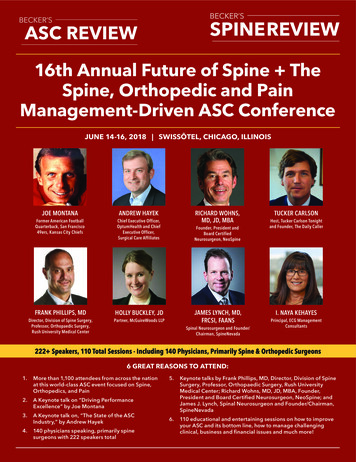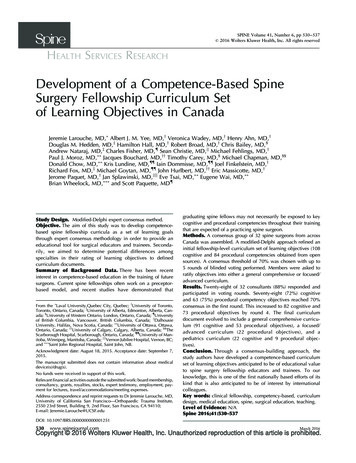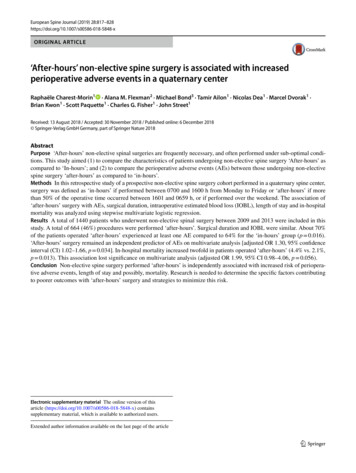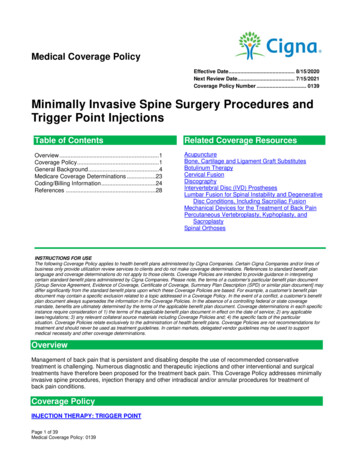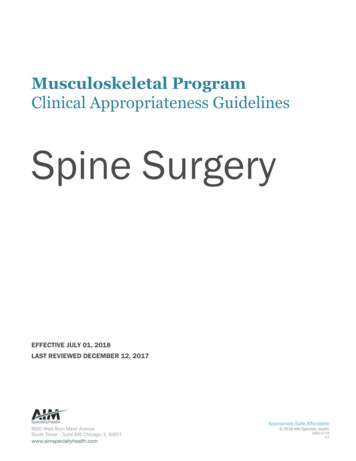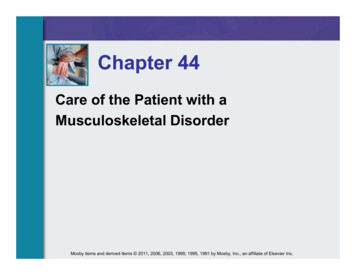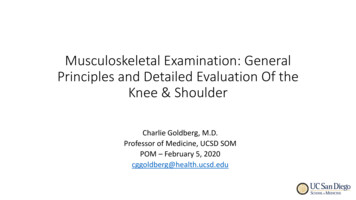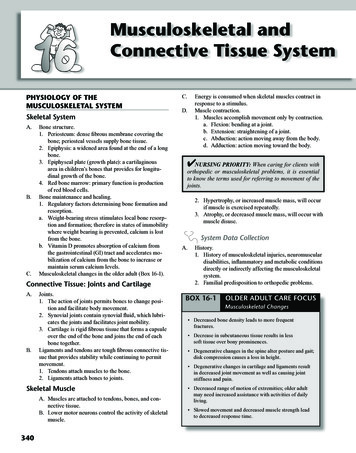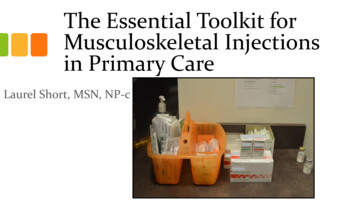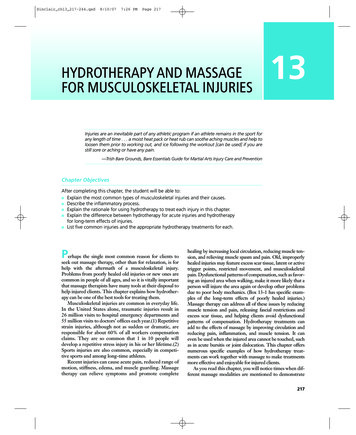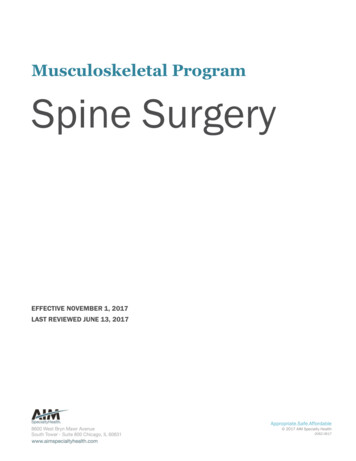
Transcription
Spine Surgery GuidelinesMusculoskeletal ProgramSpine SurgeryEFFECTIVE NOVEMBER 1, 2017LAST REVIEWED JUNE 13, 2017Appropriate.Safe.Affordable 2017 AIM Specialty Health2062-0617
Table of ContentsDescription and Application of the Guidelines 4Cervical Decompression With or Without Fusion . 5Description . 5Definitions . 6Criteria. 7Exclusions . 8Selected References . 9CPT Codes . 9Cervical Disc Arthroplasty. . 12Description . 12Definitions . 12Criteria. 13Contraindications . 13Exclusions . 14Selected References . 14CPT Codes . 14Lumbar Disc Arthroplasty . 15Description . 15Definitions . 15Criteria. 16Contraindications . 16Exclusions . 16Selected References . 17CPT Codes . 17Lumbar Discectomy, Foraminotomy, and Laminotomy . 18Description . 18Definitions . 18Criteria. 19Exclusions . 19Selected References . 20CPT Codes . 20Lumbar Fusion and Treatment of Spinal Deformity (including Scoliosis and Kyphosis) 21Description . 21General Considerations. 21Definitions . 22Exclusions . 25Selected References . 25CPT Codes . 26Copyright 2017. AIM Specialty Health. All Rights Reserved.2
Lumbar Laminectomy . 30Description . 30Definitions . 30Exclusions . 31Selected References . 31CPT Codes . 32Noninvasive Electrical Bone Growth Stimulation 33Description . 33Criteria. 33Exclusions . 34CPT/HCPCS Codes . 34Vertebroplasty/Kyphoplasty . 35Description . 35Criteria. 35Contraindications . 36Exclusions . 36Selected References . 36CPT Codes . 37Bone Graft Substitutes and Bone Morphogenetic Proteins . 38Description . 38Definitions . 38Criteria. 38Exclusions . 39CPT Codes . 39Copyright 2017. AIM Specialty Health. All Rights Reserved.3
Description and Application of theGuidelinesAIM Clinical Appropriateness Guidelines (hereinafter “AIM Clinical Appropriateness Guidelines” or the“Guidelines”) are designed to assist providers in making the most appropriate treatment decision for aspecific clinical condition for an individual. As used by AIM, the Guidelines establish objective andevidence-based, where possible, criteria for medical necessity determinations. In the process, multiplefunctions are accomplished: To establish criteria for when services are medically necessary To assist the practitioner as an educational tool To encourage standardization of medical practice patterns To curtail the performance of inappropriate and/or duplicate services To advocate for patient safety concerns To enhance the quality of healthcare To promote the most efficient and cost-effective use of servicesThe AIM guideline development process complies with applicable accreditation standards, including therequirement that the Guidelines be developed with involvement from appropriate providers with currentclinical expertise relevant to the Guidelines under review and be based on the most up to date clinicalprinciples and best practices. Relevant citations are included in the “References” section attached to eachGuideline. AIM reviews all of its Guidelines at least annually.AIM makes its Guidelines publicly available on its website twenty-four hours a day, seven days a week.Copies of the AIM Clinical Appropriateness Guidelines are also available upon oral or written request.Although the Guidelines are publicly-available, AIM considers the Guidelines to be important, proprietaryinformation of AIM, which cannot be sold, assigned, leased, licensed, reproduced or distributed without thewritten consent of AIM.AIM applies objective and evidence-based criteria and takes individual circumstances and the local deliverysystem into account when determining the medical appropriateness of health care services. The AIMGuidelines are just guidelines for the provision of specialty health services. These criteria are designed toguide both providers and reviewers to the most appropriate services based on a patient’s uniquecircumstances. In all cases, clinical judgment consistent with the standards of good medical practice shouldbe used when applying the Guidelines. Guideline determinations are made based on the informationprovided at the time of the request. It is expected that medical necessity decisions may change as newinformation is provided or based on unique aspects of the patient’s condition. The treating clinician hasfinal authority and responsibility for treatment decisions regarding the care of the patient and for justifyingand demonstrating the existence of medical necessity for the requested service. The Guidelines are not asubstitute for the experience and judgment of a physician or other health care professionals. Any clinicianseeking to apply or consult the Guidelines is expected to use independent medical judgment in the contextof individual clinical circumstances to determine any patient’s care or treatment.The Guidelines do not address coverage, benefit or other plan specific issues. If requested by a healthplan, AIM will review requests based on health plan medical policy/guidelines in lieu of the AIMGuidelines.Copyright 2017. AIM Specialty Health. All Rights Reserved.4
Cervical Decompression With or WithoutFusionDescriptionCervical spine surgery is most commonly performed for radiculopathy or cervical myelopathy. The goalof surgery is adequate decompression of the nerve roots and/or spinal cord and stabilization of thespine.Cervical decompression is performed with or without a fusion procedure and may be broadly dividedinto anterior, posterior, or combined surgical approach. The choice of procedure depends on manyfactors including: Location of the compressionPresence of deformity or instabilityNumber of levels involvedPatient age and surgical fitnessLaminoplasty is a related procedure for achieving decompression without the need for fusion, and ismost commonly utilized to treat multilevel central stenosis or ossification of the posterior longitudinalligament (OPLL).This guideline addresses the following interventions when performed as an elective, non-emergentprocedure and not as part of the care of an acute or traumatic event. Anterior cervical corpectomy and fusion (ACCF) - for long anterior compression of the spinal cordfrom spondylosis, large disc extrusions or OPLLAnterior cervical discectomy/fusion/internal fixation (ACDF) - decompression of the nerve rootsor spinal cord by disc or osteophyte removal, with or without a fusionPosterior cervical foraminotomy - for nerve root decompression in cases of soft posterolateraldisc herniation or bony foraminal stenosisPosterior laminectomy with or without fusion - for congenital stenosis, multilevel centralstenosis from spondylosis, or multiple discontinuous levels where fusion is recommended toprevent kyphotic deformity. Note that a regional kyphosis (greater than 13 ) has beenassociated with unfavorable outcomes following posterior-only surgeryPosterior laminoplasty - osteoplastic enlargement of the spinal canal (for example, by one sidedlaminectomy and hinge opening of the contralateral side)Copyright 2017. AIM Specialty Health. All Rights Reserved.5
DefinitionsConservative management should include a combination of strategies to reduce inflammation,alleviate pain, and improve function, including but not limited to the following: Prescription strength anti-inflammatory medications and analgesicsAdjunctive medications such as nerve membrane stabilizers or muscle relaxantsPhysician-supervised therapeutic exercise program or physical therapyManual therapy or spinal manipulationAlternative therapies such as acupunctureAppropriate management of underlying or associated cognitive, behavioral, or addictiondisordersDocumentation of compliance with a plan of therapy that includes elements from these areas isrequired. Exceptions may be considered on a case-by-case basis.Note: The requirement for a period of conservative treatment as a prerequisite to a surgical procedureis waived when there is evidence of progressive nerve or spinal cord compression resulting in asignificant neurologic deficit, or when myelopathy, weakness, or bladder disturbance is present.Reporting of symptom severity – Severity of pain and its impact on activities of daily living (ADLs) is akey factor in determining the need for intervention. For purposes of this guideline, significant pain andfunctional impairment refers to pain that is at least 3 out of 10 in intensity and is associated withinability to perform at least two (2) ADLs.Tobacco cessation – Due to risk of pseudoarthrosis, elective spinal fusion requires adherence to atobacco-cessation program that results in abstinence from tobacco for at least six (6) weeks prior tosurgery. Documentation of nicotine-free status by laboratory testing (e.g., cotinine level orcarboxyhemoglobin) is recommended. Labs are to be performed after six (6) weeks tobacco cessationand ample time should be afforded to submit this confirmation and complete the prior authorizationprocess.Imaging studies – All imaging must be performed and read by an independent radiologist. Ifdiscrepancies should arise in the interpretation of the imaging, the radiologist report will supersede.The results of all imaging studies should correlate with the clinical finding
Cervical spine surgery is most commonly performed for radiculopathy or cervical myelopathy. The goal of surgery is adequate decompression of the nerve roots and/or spinal cord and stabilization of the spine
